In mammals, milk production starts during pregnancy, especially toward the end. Cows are mammals that are usually kept for milk. But when do cows start producing milk and what factors should be considered for save and healthy milking?

Can a pregnant cow be milked?
Pregnant cows be milked. in fact, you can only milk a cow that has been pregnant and given birth. Once the cow gives birth, she is often rebred so that she can produce milk again next year. Cows that produce milk are pregnant most of the year.
The hormones responsible for milk production in cows reach their threshold levels during pregnancy.
In some cows, milk production falls as the pregnancy comes to an end. But in others, it stays the same even after giving birth.
Not all cows are the same, and you’ll find that different factors affect the variables of milk production in cows.
Table of Contents
Milking a Pregnant Cow
A pregnant cow can be milked, and milk production starts during pregnancy. Toward the second and third trimester, the levels of hormones such as progesterone and estrogen increase and promote the development of the lactation system in the udder.
Besides progesterone and estrogen, two other hormones play a part in cow milk production and secretion. These hormones are oxytocin and prolactin.
Most cows will produce milk during pregnancy, but the volume varies. Factors like breed, genetics, nutrition, environment, and age affect how much milk you can get from a cow.
Dairy cows are bred specially for milk production. The volume of milk you’ll get from them is usually way more than what their calf can consume.
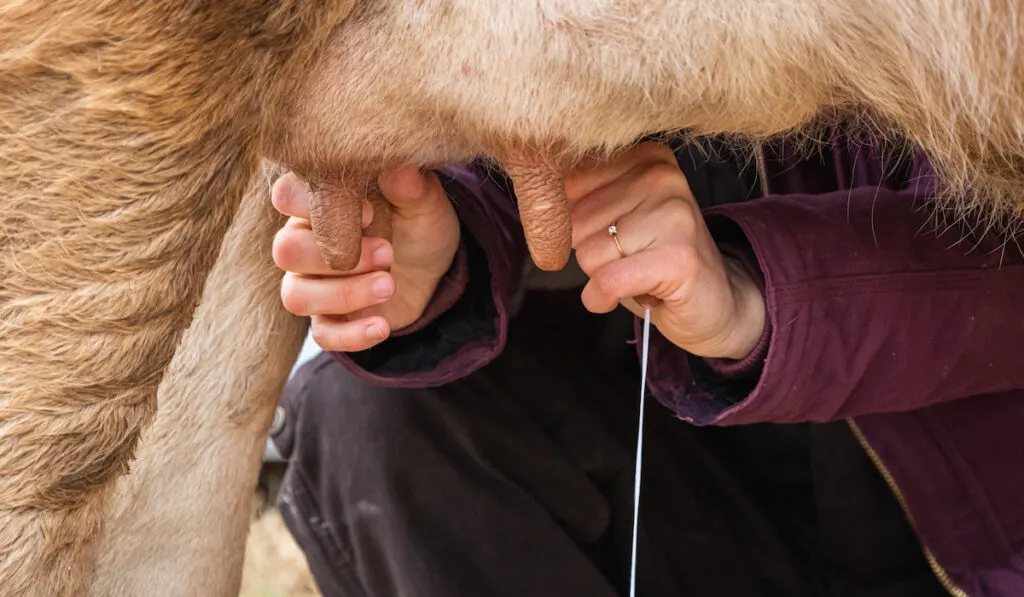
When to Stop Milking a Pregnant Cow
Cows are not milked throughout pregnancy. After a period of milking, you have to stop to allow the udder to rejuvenate for the next lactation period.
Most cows are not milked continuously. As they get closer to their calving date, you have to stop milking them.
When you stop milking a cow, it becomes dry and enters what is called the dry period. This period is at least 60 days before the cow’s calving date.
A pregnant cow should not be milked during the last 60 days of her pregnancy and within the first few days following birth.
Cows need the dry period for them to continue producing milk at their usual level. If the dry period is less than 60 days, you might get a lower yield from the cow during the next lactation period.
At the same time, you do not want a dry period significantly longer than 60 days. Lengthy dry periods can be problematic causing the cow to become fat. They can also develop metabolic disorders that reduce milk production.
It is critical to stop milking your cow around 60 days before calving. But how do you know your cow is ready for the dry period? You calculate.
The gestation period of a cow is between 275 and 283 days starting from the day servicing took place.
You should stop milking the cow around between 215 and 223 days. Since gestation can end earlier than day 283, you can choose to stop milking earlier than day 223.
If you aren’t sure when the cow was bred, it’s best to err on the side of caution and start calculating from the first day she was in with the bull.
Colostrum vs. Milk
What Is Colostrum?
Immediately after a cow calves, the first milk it produces is called colostrum. This substance differs from the content in typical cow milk.
Colostrum is thick, yellow, and contains more solids than milk. The levels of fats, protein, vitamins, minerals, cytokines, nucleotides, and growth factors are higher in colostrum than in milk. But the amount of lactose in colostrum is lower than in milk.
Colostrum is very crucial to calves, and they must get it within the first 24 hours of their lives. After 24 hours, the ability of the calves’ gut to absorb the antibodies (immunoglobins) in colostrum reduces markedly.
At birth, calves have no immune system. However, the antibodies present in colostrum protect them from diseases until their immune system is fully formed.
Colostrum forms before the calf is born and, without it, most calves will die. This is yet another reason it is extremely crucial that a cow not be milked prior to calving or, within the first few days after giving birth.
You want to make sure that the calf has the best chance at living by making sure he can drink colostrum that is rich in antibodies.
How to Know When the Cow Is Producing Milk vs. Colostrum
Roughly 35-45 days before calving, cows start producing colostrum. After calving, colostrum is typically produced for 3 days before usual milk production resumes.
But how do you know when the cow is producing milk and not colostrum? You can tell when the change happens by observing the color of the milking liquid.
Colostrum has a yellowish color and a thick consistency. On the other hand, milk is white and has a thin or watery consistency.
Just remember that as birthing gets near you don’t want to “check” the cow for colostrum too frequently (or at all). Not all cows produce the same volume and you don’t want to reduce the quantity that is available for the calf when it is born.
If you are worried that your cow has not produced colostrum, a vet can perform a blood test to make sure the new calf has the antibodies it needs. I
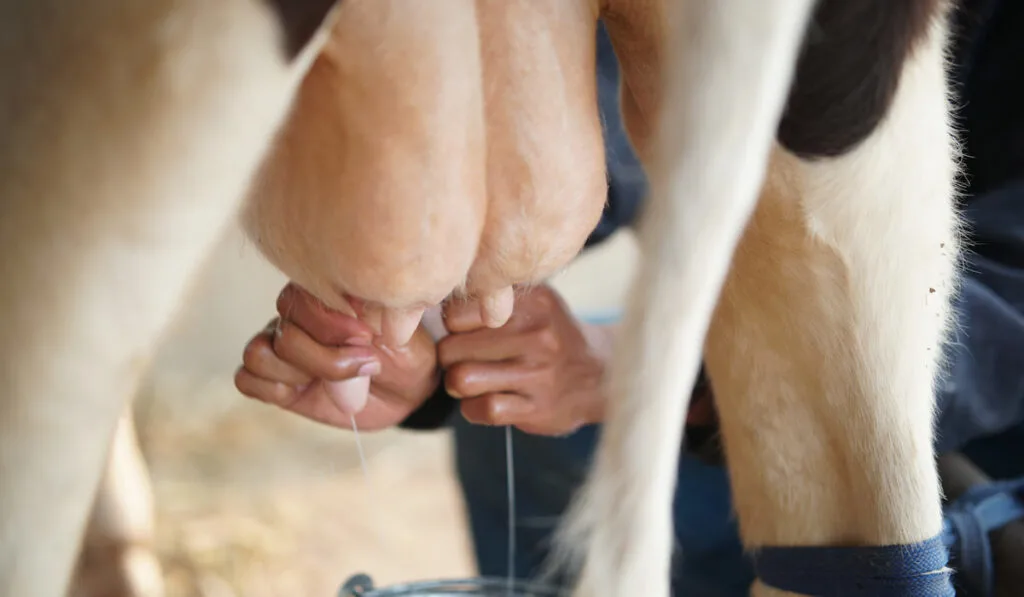
Can You Milk a Cow That Is Nursing a Baby?
You can milk a cow that is nursing a baby. She should have more than enough milk for you and her calf. Be sure to still take precautions to properly clean the udder before milking and pasteurize the milk before drinking.
Cows start nursing their calves immediately after calving. They lick their newborn calves clean, and then they feed them from their udder.
After 2 weeks, dried foods are introduced into the calves’ diet. By week 8, the calves are weaned.
At commercial dairy farms, the farmers separate the calves from their mothers just a few days after birth so they can milk the cows without worrying that the babies will get hurt.
Calves separated from their mothers are typically provided milk in a bucket so that they can grow. On your own farm, it’s more reasonable to leave the baby with the mom, as nature intended.
While it is safe to milk a cow that is nursing a baby, separating them can cause problems. Early separation can make both mother and calf distressed. They may express their distress by making loud calls to each other.
Bottle feeding isn’t fun so, if you can, leaving the calf with the cow is fine, even if you plan on milking her.
Will the Baby Have Enough to Eat?
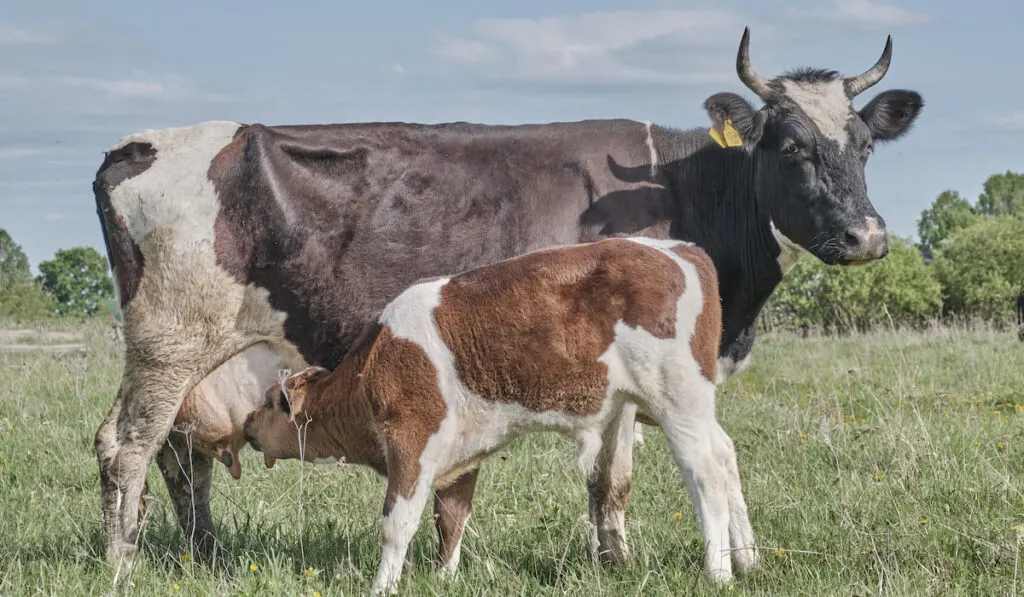
Calves need to get enough nutrients for them to grow properly. Most cows can support the needs of both their calf and a single regular household.
If, however, you are miking on a more commercial scale or, for a large number of people, it is possible the cow won’t be able to produce enough milk to feed everybody.
But how do you know you’re not taking all the milk and leaving the calf with almost nothing?
On average, calves consume a volume of milk equal to 10% of their weight. So, a calf weighing 80 pounds will consume 8 pounds of milk per day. Converting 8 pounds to gallons gives 1 gallon per day.
The average lactating cow produces about 6.5 gallons of milk every day. So, an 80-pound calf should have enough to eat after you milk its mother.
To determine whether your calf will still get enough to eat after milking, measure its weight, and estimate its daily milk consumption.
Then determine the average volume of milk its mother produces per day. The difference between both values will tell you how much milk you can take before you leave the calf with less than enough.
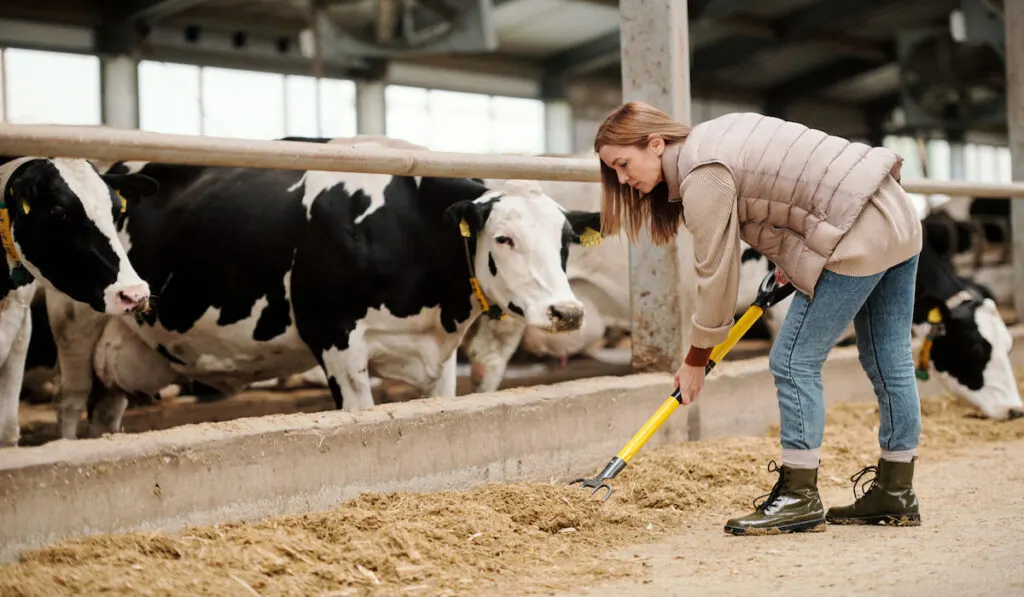
Improving Milk Production in Cows
The good news is that you can boost your cows’ milk production. All you need to do is feed them properly.
The University of Kentucky recommends 25 pounds of quality hay daily for cows that produce a normal amount of milk.
For cows that produce more than the usual amount of milk, the University of Kentucky recommends 30 pounds of quality grass-legume hay daily.
In place of hay, you may give the cows a combination of corn silage and alfalfa hay or corn silage and protein supplement.
For cows that produce normal amounts of milk, give 65 pounds of corn silage + 1 pound of protein supplement or 55 pounds corn silage + 5 pounds alfalfa hay.
For cows that produce large amounts of milk, give 60 pounds of corn silage + 2.5 pounds of protein supplement, or 50 pounds corn silage + 10 pounds alfalfa hay.
How Long Do Cows Produce Milk After Giving Birth?
Milk production in cows peaks about around 40-60 days after calving. Then production gradually reduces until it stops after 10 months.
This then starts the dry period during which the udder rests and restores itself in preparation for future lactation.
Do Male Cows Produce Milk?
Cows can only produce milk when they are pregnant. Male cows do not get pregnant, so they cannot be kept for milk.
Male cows are kept for 3 main reasons: for breeding, for meat, and as a draft animal.
Male cows kept for breeding are called bulls. Bulls are uncastrated to allow them to play their role in servicing cows.
Male cows kept for meat are called steers. Those used as draft animals are typically a special type of bovine called oxen. Steers and oxen are castrated.
Castration makes male cows easier to control, reduces aggressiveness, and makes the farm safer for handlers.
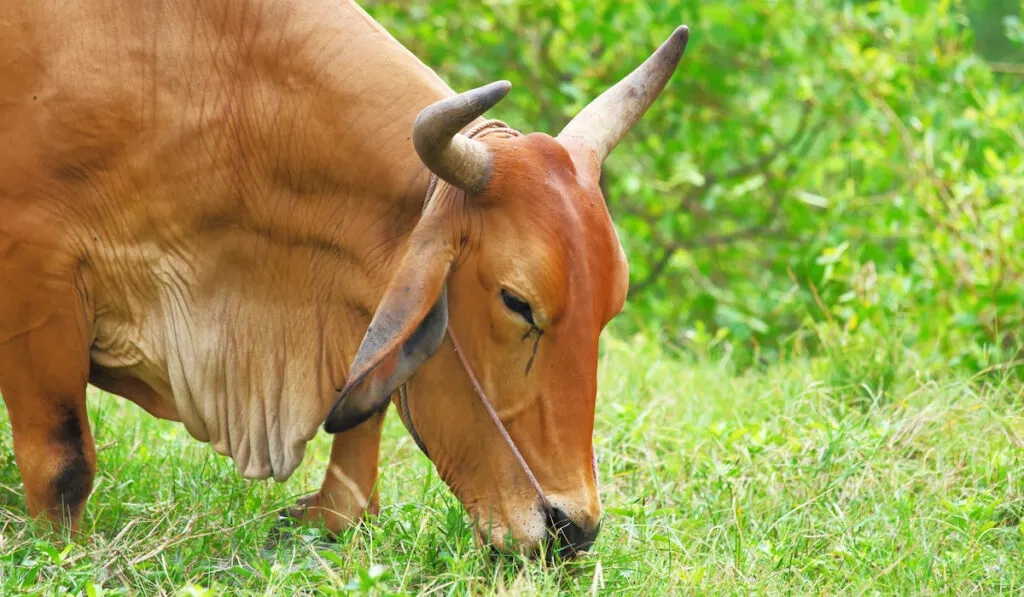
Do Male Cows Have Udders?
If you’ve always thought that you could tell the gender of cattle by their horns, then you will most likely make a wrong deduction. Both male and female cattle can grow horns.
But if you look towards the hind legs of cattle, you can easily detect their gender.
Female cows that have calved before will have an udder. Those that have not been pregnant will have teats with no evident udder.
Male cows do not have udders. If it’s a bull, you’ll notice the scrotum between the hind legs but no udder.
However, since steers are castrated, you will see no scrotum and no udder between their hind legs.
Final Thoughts
Pregnancy is the only way for a cow to produce milk. While pregnant cows can be milked, be sure to follow guidelines for rest periods to ensure a safe pregnancy as well as proper care for newborn calves.
Resources
- https://www.dairy.com.au/dairy-matters/you-ask-we-answer/is-it-true-that-cows-can-only-produce-milk-if-they-have-been-pregnant
- https://www.farmersweekly.co.za/farm-basics/how-to-livestock/lactation-begins-at-dry-off/
- https://www.thefarmerswifee.com/are-dairy-cows-constantly-pregnant/
- https://diaresq.com/blog/colostrum-vs-milk-whats-difference
- https://kb.rspca.org.au/knowledge-base/how-much-milk-should-dairy-calves-be-fed/
- https://animals.mom.com/much-feed-cow-nursing-calf-11370.html
- https://www.ciwf.org.uk/media/5235185/the-life-of-dairy-cows.pdf
- http://www.omafra.gov.on.ca/english/livestock/beef/facts/07-029.htm
